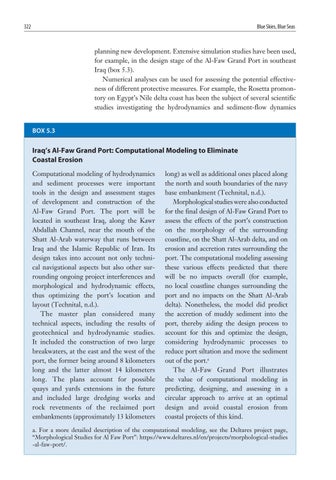322
Blue Skies, Blue Seas
planning new development. Extensive simulation studies have been used, for example, in the design stage of the Al-Faw Grand Port in southeast Iraq (box 5.3). Numerical analyses can be used for assessing the potential effectiveness of different protective measures. For example, the Rosetta promontory on Egypt’s Nile delta coast has been the subject of several scientific studies investigating the hydrodynamics and sediment-flow dynamics BOX 5.3
Iraq’s Al-Faw Grand Port: Computational Modeling to Eliminate Coastal Erosion Computational modeling of hydrodynamics and sediment processes were important tools in the design and assessment stages of development and construction of the Al-Faw Grand Port. The port will be located in southeast Iraq, along the Kawr Abdallah Channel, near the mouth of the Shatt Al-Arab waterway that runs between Iraq and the Islamic Republic of Iran. Its design takes into account not only technical navigational aspects but also other surrounding ongoing project interferences and morphological and hydrodynamic effects, thus optimizing the port’s location and layout (Technital, n.d.). The master plan considered many technical aspects, including the results of geotechnical and hydrodynamic studies. It included the construction of two large breakwaters, at the east and the west of the port, the former being around 8 kilometers long and the latter almost 14 kilometers long. The plans account for possible quays and yards extensions in the future and included large dredging works and rock revetments of the reclaimed port embankments (approximately 13 kilometers
long) as well as additional ones placed along the north and south boundaries of the navy base embankment (Technital, n.d.). Morphological studies were also conducted for the final design of Al-Faw Grand Port to assess the effects of the port’s construction on the morphology of the surrounding coastline, on the Shatt Al-Arab delta, and on erosion and accretion rates surrounding the port. The computational modeling assessing these various effects predicted that there will be no impacts overall (for example, no local coastline changes surrounding the port and no impacts on the Shatt Al-Arab delta). Nonetheless, the model did predict the accretion of muddy sediment into the port, thereby aiding the design process to account for this and optimize the design, considering hydrodynamic processes to reduce port siltation and move the sediment out of the port.a The Al-Faw Grand Port illustrates the value of computational modeling in predicting, designing, and assessing in a circular approach to arrive at an optimal design and avoid coastal erosion from coastal projects of this kind.
a. For a more detailed description of the computational modeling, see the Deltares project page, “Morphological Studies for Al Faw Port”: https://www.deltares.nl/en/projects/morphological-studies -al-faw-port/.
